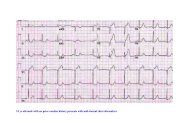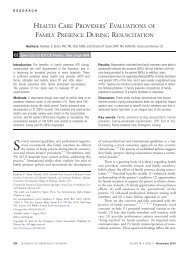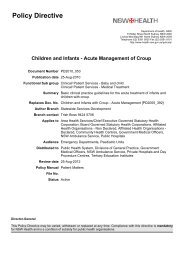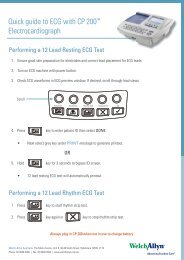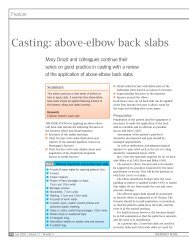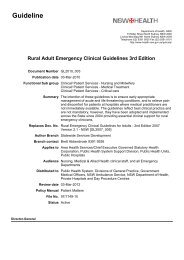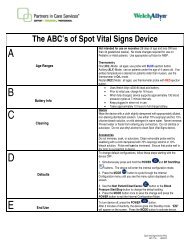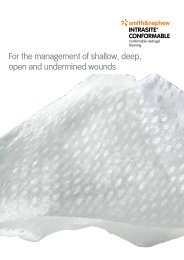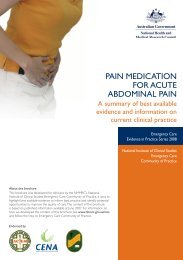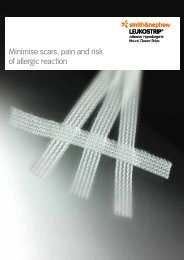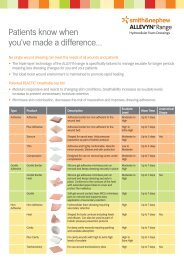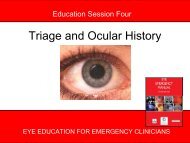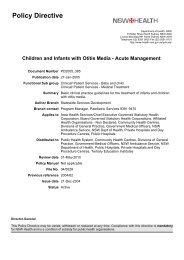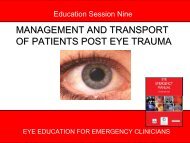Clinical Guidelines for Acute Stroke Management - Living on the EDge
Clinical Guidelines for Acute Stroke Management - Living on the EDge
Clinical Guidelines for Acute Stroke Management - Living on the EDge
Create successful ePaper yourself
Turn your PDF publications into a flip-book with our unique Google optimized e-Paper software.
8.8 Return to driving after stroke or TIA<br />
Secti<strong>on</strong> 8 Discharge Planning, Transfer of Care and Integrated Community Care<br />
The issue of returning to driving can be c<strong>on</strong>fusing and<br />
<strong>the</strong> topic is often raised by <strong>the</strong> patient or <strong>the</strong>ir<br />
family/carer, especially <str<strong>on</strong>g>for</str<strong>on</strong>g> patients with minor stroke or<br />
TIA. Currently <strong>the</strong>re are Nati<strong>on</strong>al <str<strong>on</strong>g>Guidelines</str<strong>on</strong>g> <str<strong>on</strong>g>for</str<strong>on</strong>g> Driving<br />
472<br />
as well as state or local guidelines. The current<br />
Nati<strong>on</strong>al <str<strong>on</strong>g>Guidelines</str<strong>on</strong>g> describe c<strong>on</strong>diti<strong>on</strong>s <str<strong>on</strong>g>for</str<strong>on</strong>g><br />
unc<strong>on</strong>diti<strong>on</strong>al licences and where c<strong>on</strong>diti<strong>on</strong>al licences<br />
exist. Patients with stroke automatically have a<br />
c<strong>on</strong>diti<strong>on</strong>al licence and are not to return to driving<br />
<str<strong>on</strong>g>for</str<strong>on</strong>g> a minimum of 1 m<strong>on</strong>th if <strong>the</strong>re are significant<br />
neurological, perceptual or cognitive deficits.<br />
A physician assessment should be undertaken be<str<strong>on</strong>g>for</str<strong>on</strong>g>e<br />
returning to drive and where necessary (where stroke<br />
deficits are deemed to potentially impact <strong>on</strong> driving)<br />
a driver assessment. There is currently no restricti<strong>on</strong><br />
in place <str<strong>on</strong>g>for</str<strong>on</strong>g> those with first TIA, however, restricti<strong>on</strong>s<br />
apply when <strong>the</strong> pers<strong>on</strong> has had two or more TIAs.<br />
In such cases a c<strong>on</strong>diti<strong>on</strong>al licence may be granted<br />
taking into account <strong>the</strong> opini<strong>on</strong> of <strong>the</strong> treating<br />
doctor/GP, and <strong>the</strong> nature of <strong>the</strong> driving task, and<br />
subject to periodic review if <strong>the</strong> aetiology of <strong>the</strong> TIAs<br />
has been identified, <strong>the</strong> underlying cause removed,<br />
and <strong>the</strong> pers<strong>on</strong> has had a 6 m<strong>on</strong>th period free of<br />
attacks. 472<br />
State based guidelines describe <strong>the</strong> resp<strong>on</strong>sibilities of<br />
<strong>the</strong> patient, <strong>the</strong> treating doctor or both. In general <strong>the</strong>y<br />
recommend a period without driving. The ABCD 2 tool<br />
may assist to screen those at high risk after TIA and to<br />
in<str<strong>on</strong>g>for</str<strong>on</strong>g>m <strong>the</strong> decisi<strong>on</strong> and advice provided to patients<br />
and <strong>the</strong>ir families. Those with a high risk should clearly<br />
be advised to avoid driving given <strong>the</strong> higher risk of<br />
stroke within <strong>the</strong> first few weeks.<br />
In all cases, people with stroke who held a driving<br />
licence pre-stroke should be provided with written<br />
in<str<strong>on</strong>g>for</str<strong>on</strong>g>mati<strong>on</strong> about returning to drive including legal<br />
obligati<strong>on</strong>s and necessary assessments. This<br />
in<str<strong>on</strong>g>for</str<strong>on</strong>g>mati<strong>on</strong> should be provided prior to discharge from<br />
hospital or preferably within <strong>the</strong> first visit in <strong>the</strong> case of<br />
those not admitted to hospital.<br />
Fur<strong>the</strong>r discussi<strong>on</strong> about assessment and<br />
management of driving after stroke is found in <strong>the</strong><br />
<str<strong>on</strong>g>Clinical</str<strong>on</strong>g> <str<strong>on</strong>g>Guidelines</str<strong>on</strong>g> <str<strong>on</strong>g>for</str<strong>on</strong>g> <str<strong>on</strong>g>Stroke</str<strong>on</strong>g> Rehabilitati<strong>on</strong> and<br />
Recovery.<br />
CONSUMER<br />
8.8 RETURN TO DRIVING GRADE LEVEL RATING<br />
The Nati<strong>on</strong>al <str<strong>on</strong>g>Guidelines</str<strong>on</strong>g> <str<strong>on</strong>g>for</str<strong>on</strong>g> Driving and relevant state guidelines should ✓ – 9.7/10<br />
be followed when assessing fitness to drive following a stroke or TIA.<br />
In general, patients with TIA or minor stroke, especially those found to<br />
be at high risk, should be advised to delay returning to driving <str<strong>on</strong>g>for</str<strong>on</strong>g> at<br />
least 1- 4 weeks.<br />
56



